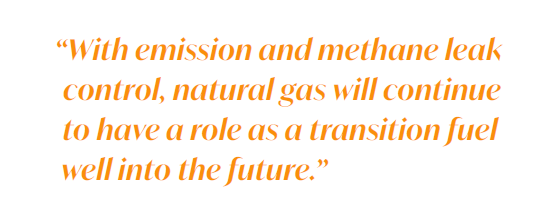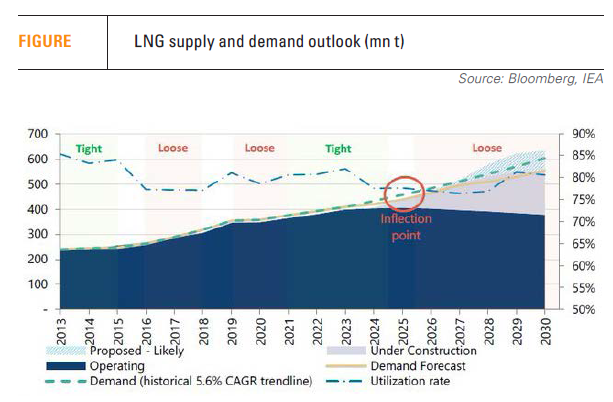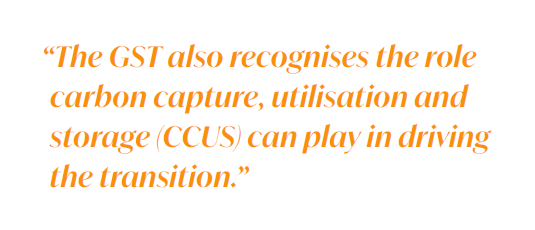What COP28 means for natural gas [Gas in Transition]
The immediate reaction to COP28’s Global Stock-Take Agreement (GST) was that it signals the “beginning of the end of fossil fuels” by laying the ground for a swift, just and equitable transition, underpinned by deep emissions cuts. The exact wording is that the COP recognises the need for “transitioning away from fossil fuels in energy systems, in a just, orderly and equitable manner, accelerating action in this critical decade, so as to achieve net zero by 2050 in keeping with the science.”
Even though this is a historic agreement in that for the first time it commits to “transitioning away from fossil fuels,” it still leaves a role for oil and gas in future energy systems for a long time to come. And as Bloomberg points out, the choice of wording – transitioning away from fossil fuels – “puts the onus on the demand side, rather than on production.” With both global oil and gas demand carrying on increasing, production responds to market signals. This also ensures “orderly” transition.
 Another first was recognition of the need for “Phasing out inefficient fossil fuel subsidies that do not address energy poverty or just transitions, as soon as possible.” But it lacks detail to be effective.
Another first was recognition of the need for “Phasing out inefficient fossil fuel subsidies that do not address energy poverty or just transitions, as soon as possible.” But it lacks detail to be effective.
The GST also recognises that natural gas has a role to play as a transition fuel. The exact wording is that the COP “recognises that transitional fuels can play a role in facilitating the energy transition while ensuring energy security.” Many interpret reference to “transitional fuels” as a code-name for natural gas.
The reference to energy security is particularly important, given the intermittent nature of renewable energy sources. Gas, as the cleanest fossil fuel, is seen as a companion to renewables during energy transition, ensuring energy security.
It is also a cleaner replacement for the much dirtier coal -provided it tackles its methane leakage problem. Most credible outlooks show natural gas demand growing all the way to 2050. The International Energy Agency (IEA) differs, showing demand to peak by 2030 and to remain more or less flat to 2050, but this is based on assuming drastic reductions in Chinese economic growth, below most other credible forecasts.
SEB bank analysts said “the deal emphasises an important role for natural gas in the energy transition, which the industry has long said was necessary to reduce use of coal and oil as renewable capacity ramps up.”
The GST calls for “tripling renewable energy capacity globally and doubling the global average annual rate of energy efficiency improvements by 2030.” If implemented and achieved, and intermittency is dealt with, it could potentially have a significant impact on the electricity fuel mix, decreasing the use of fossil fuels in power generation. But this requires too many ‘ifs’ to actually happen.
Saudi Arabia and other OPEC countries acceptred the COP28 deal because it allows countries to follow their own pathways in its implementation. The GST “calls on Parties to contribute to the following global efforts [listed in the GST], in a nationally determined manner, taking into account the Paris Agreement and their different national circumstances, pathways and approaches.”
OPEC and the Gas Exporting Countries Forum (GECF) jointly congratulated the UAE for "the consensual and positive outcome" of COP28.
A boost for natural gas demand
In a recent equity research paper, Jefferies International, that specializes in investment banking and capital markets, reported that 2024 will be the last year of global LNG market tightness. Based on its demand forecasts, the market will be balanced in 2025 and shift into a loose market in 2026 (see figure 1). As prices come down, it should boost natural gas demand further, as it becomes a substitute for coal.
The position of the LNG industry would be substantially enhanced if it joins the ᾽Oil and Gas Decarbonization Charter’ (OGDC), announced at COP28, and adopts its zero methane leakage pledge. This would go a long way to legitimizing LNG as a transition fuel.
China expects its own natural gas production to carry on increasing to meet rising demand, forecast to increase from 365bn m3 in 2022 to about 550bn m3 by 2030.
Gas helps deal with urban air pollution caused by coal use. Coinciding with COP28, China released an action plan early December committing to control coal use to improve air quality.
Over the last decade oil and gas majors have been making big investments into natural gas assets and projects. In addition, major economies, such as China, India and Japan, see increasing investment in gas as necessary to ensure future energy security.
Gas industry participants at COP28 said they expect that, with emission and methane leak control, natural gas will continue to have a role as a transition fuel well into the future, especially as long as solar and wind intermittency remains a problem.
A role for CCUS
The GST also recognises the role carbon capture, utilisation and storage (CCUS) can play in driving the transition, by reducing the carbon intensity of industries and processes that consume fossil fuels.
The GST states that the COP recognizes the need for “accelerating zero- and low-emission technologies, including, inter alia, renewables, nuclear, abatement and removal technologies such as carbon capture and utilization and storage, particularly in hard-to-abate sectors, and low-carbon hydrogen production.”
Saudi Arabia and other oil and gas producers, as well as oil and gas majors, have long been advocating use of CCUS to abate emissions from the use of these fuels.
Even though CCUS remains expensive, there has been major progress in its implementation over the last few years driven by falling costs, higher carbon emission allowance costs and by policies, credits and support in schemes such as the Inflation Reduction Act (IRA) in the US. The GST is making CCUS not only possible but also necessary. With such help, CCUS can become a serious option for emission abatement.
The IEA agrees that CCUS “has grown substantially in recent years, with over 500 projects in various stages of development across the CCUS value chain,” but it warns that deployment remains “well below what is required in its Net Zero Scenario.”
Following their November 15 meeting, the US and China agreed to cooperate to build at least five large-scale CCUS projects each by 2030.
As McKinsey suggests, regulators can help by “creating frameworks to build up the industry, and recognize the reality that early CCUS projects will need support.”
But let’s be real
Historically, COP agreements come and go with little impact in the real world. Take coal as an example. COP26 in Glasgow in 2021 agreed to accelerate efforts to “phase-down unabated coal power”, wording that has been retained in this year’s GST. As for fossil fuels now, the headline then was “end of coal in sight.” But in reality, the COP26 text has not had any impact so far. Coal consumption increased by 3.3% in 2022 and is expected to increase by more than 1.5% in 2023.
It is not that the world blatantly ignores the polluting nature of coal, but energy security and low cost appear to matter more, especially in Asia-Pacific, than COP agreement wording. As long as energy security and reliability are not guaranteed, flexible fuels such as coal and gas will have a role to play in energy transition. The end of coal will come when a cheaper and reliable fuel becomes abundantly available to replace it. Increasingly, that role is being provided by natural gas.
Another reality is that, despite commitments made, COP28 did not mobilise sufficient finance to help developing countries transition away from fossil fuels. Yet again there is no agreement on how energy transition will be funded. The COP28 deal states that “adaptation and mitigation financing would need to increase manyfold,” estimated to be in trillions of dollars. This could make new goals, such as tripling renewables by 2030, difficult to achieve in the developing world, prolonging high dependence on fossil fuels.
The GST will not impact oil and gas consumption, not for a while yet. In fact, with gas now being recognized as a transition fuel, its use may now increase to replace coal, as evidenced by China’s new action plan to control coal.
Even the US, despite its leading role in Dubai, is still expanding its oil and gas production. And so are Canada, Norway and Australia. Europe has also been building new LNG import terminals, driven by energy security concerns.
But with COP28 having made a start, future COPs now have the opportunity to build on “transitioning away from fossil fuels,” incrementally. The longer-term transformation of global energy systems has just begun, but it will take decades. Statements like “stranded fossil assets are now more, not less likely, following this COP and the momentum it will generate,” are premature.



